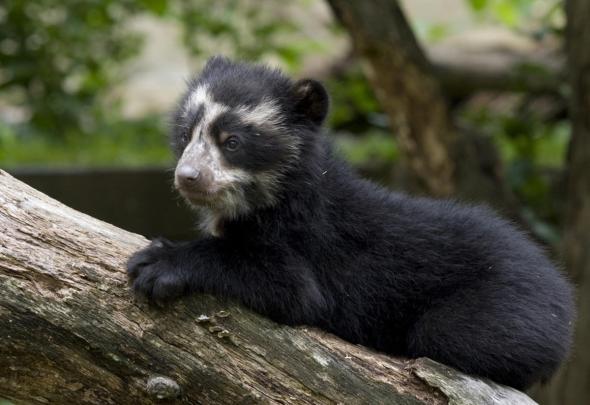
Endangered Species Monday: Tremarctos ornatus
This January’s (2016) Endangered Species Watch Post is dedicated to the Tremarctos ornatus, commonly known as the Andean Bear or Spectacled Bear. The species was identified by Dr Jean Léopold Nicolas Frédéric Cuvier back in 1825. Dr Jean Léopold Nicolas Frédéric Cuvier lived from (23 August 1769 – 13 May 1832), known as Georges Cuvier, was a French naturalist and zoologist, sometimes referred to as the “Father of paleontology”. Cuvier was a major figure in natural sciences research in the early 19th century and was instrumental in establishing the fields of comparative anatomy and paleontology through his work in comparing living animals with fossils.
From 1982 to 1996 the Andean Bear has been listed as (vulnerable), of which its main threats are habitat loss and major poaching for the animal parts trade. Within the past thirty years populations have declined by a staggering 30% which qualifies the bear as being listed as (vulnerable). Habitat loss continues at a rate of 2-4% per year, which as yet doesn’t look set to decline. Furthermore identified threats do not look set to decrease anytime soon which could see this stunning animal pushed into extinction very soon.
Poaching is one of the main problems that can be controlled if (anti poaching enforcement) is increased within the bears habitat, unfortunately this is easier said than done. Furthermore, continued habitat destruction and illegal logging will see forest tracks opened up within the bears natural habitat, thus allowing poachers to walk freely into the bears home environment, thus seeing poaching occur. Anti poaching enforcement is a must, and needs to be taken seriously by all international (non-governmental organisations) that are working to sustain this animals welfare, and habitat.
Endemic to Bolivia, Colombia; Ecuador; Peru, and Venezuela, populations of the Andean Bear are now known to be decreasing rapidly, however populations are not reported to be (fragmented). Back in 1998 it was estimated by Dr Peyton that there was a mere 20,000 Andean Bears remaining. A 2003 survey, however estimated that there was in between 5,000 to 30,000 Andean Bears remaining. Andean Bears are now commonly located within the eastern Andes of which bear populations exist from the snowline down to 300 m asl in the Tapo-Caparo National Park in Venezuela. Andean Bears can also be located at high altitudes in Ecuador, Peru, Bolivia, and Columbia.
Andean Bears are “omnivores”, meaning that they feed exclusively on plant matter, fruits, bark and occasionally will consume meat of other animals, the bears preferred diet though is reported to be species of flora from the Bromeliaceae and Arecaceae. Activity patterns range from strictly diurnal for wild bears in Bolivia to mixed diurnal and nocturnal for reintroduced bears in Ecuador.
“EXTINCTION BY 2030 IS POSSIBLE”
As food is available year-round in all parts of their range, Andean bears do not hibernate. Based on the first few individuals of this species to be monitored using ground telemetry in Bolivia and Ecuador, home ranges overlap to a high degree and minimum home range sizes vary from 10 to 160 km² (although these are underestimates, as the bears were regularly out of range of radiotelemetry in both studies).
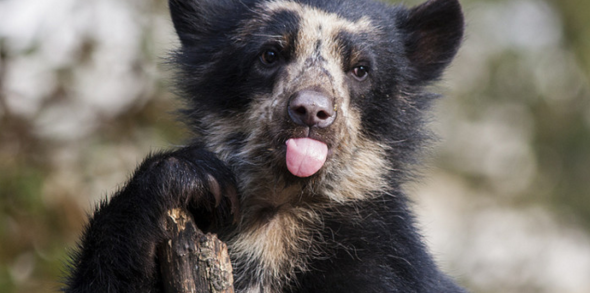
The Andean Bear stands at around 5ft to 6ft tall, and weighs in at around 220, 330lbs. The markings on the Andean bear’s face, neck and chest are exactly like human finger prints (unique to each and every individual Andean Bear). Andean bears are very timid and shy and prefer to live in isolated cloud forests, of which they are “mainly nocturnal” however will at times feed, live and socialize in daylight (although this is considered rare). Favorite foods are cacti, berries and of course honey.
Andean bears are quite typically solitary animals, and will only be seen in pairs during mating season. Females normally give birth to (1-2 cubs), cubs are normally mobile after one month, however will remain with their “mother” for up to eight months, mothers will often be seen with little cub hitching a ride on the back on the mothers back. Population studies state today that there may be no fewer than 3,000 Andean bears in the wild., which if true could soon see the species nearing extinction by 2030.
ANDEAN BEAR THREATS
Habitat loss and fragmentation, poaching, and the lack of knowledge about the distribution and status of the Andean Bear are the principal threats to this species. Much of the range of the Andean Bear has been fragmented by human activities, largely resulting from the expansion of the agricultural frontier. In some areas, mining, road development and oil exploitation are becoming a greater menace to Andean Bear populations as well as to local communities, due to land expropriation, loss of habitat connectivity, and water and soil contamination.
Many Andean Bear populations are isolated in small to medium-sized patches of intact habitat, particularly in the northern part of the range. The situation tends to improve towards the southern range, with some large patches of wilderness still remaining. Nevertheless, human population growth and national development plans throughout the Tropical Andes continue to be an important cause of habitat fragmentation and to threaten the connectivity among remaining wilderness patches.
Poaching is a serious threat throughout the Andean Bear range. Bears are often killed after damaging crops, particularly maize, or after purportedly killing livestock. Also, Andean Bear products are used for medicinal or ritual purposes and at some localities Andean Bear meat is highly prized. Live bears are also sometimes captured and sold.
Human induced mortality endangers the viability of small remnant populations. Lack of knowledge about the distribution and status is a problem throughout the region. In many areas, information about the status of Andean bears is outdated or, particularly in the southern portion of the range, simply non-existent. The absence of knowledge makes it difficult to develop realistic management plans for the conservation of this species, or to monitor changes in its distribution (reflective of changes in population status).
It is without a doubt the Andean Bear is facing “imminent extinction”, and from studies that are being conducted by various organisations including the International Animal Rescue Foundation Brazil, its very likely this animal is going to be pushed into extinction very soon.
Thank you for reasding the first part of this years (2016) Endangered Species Watch Post, and please feel free to scroll through 2014-2015’s posts below via the automatic scroll new feed bar.
Dr Jose C. Depre PhD. MEnvSc. BSc(Hons) Botany, PhD(NeuroSci) D.V.M. Environmental & Human Science
Chief Environmental Officer and Director
[email protected]
Donate today and help us continue our worldwide anti-wildlife trade enforcement operation continuing. Please click the DONATE button below.
DONATE BUTTON
January 11, 2016 | Categories: You must be the change you want to see in the world | Tags: and Venezuela, Andean, Andean Bear, Andean Bear Extinction, Arecaceae, Bears, Bolivia, Bromeliaceae, Colombia; Ecuador; Peru, Columbia, Dr Jean Léopold Nicolas Frédéric Cuvier, Dr Jose Depre. International Animal Rescue Foundation Brazil, Endangered, Habitat Loss, paleontology, Peru, Poaching, radiotelemetry, South America, Spectacled Bear, Tapo-Caparo National Park, Tremarctos ornatus, Venezuela, Vulnerable | Leave a comment

CRUEL CAPYBARA LEATHER AND MEAT TRADE
Introduction:
Many people reading this article may never have seen or heard of the Capybara, however the species is still just extant of which both the lesser Capybara and greater Capybara are facing extinction due to over-hunting, poaching and unfortunately the cruel, barbaric leather and fashion trade. (Image: Capybara killed for meat and skin)
Endemic to South America the Capybara that is classed as a rodent is the largest rodent of its kind on the face of the planet. Furthermore due to its craved after soft hide the Argentinian and Peruvian government back in the 1960’s regulated the trade of Capybara from which the worlds largest rodent is now nothing more than a fashion accessory.
International Animal Rescue Foundation Brazil have been undertaking investigations on Argentinian Capybara farms where they have located some of the most unpleasant abusive regimes. Filthy and repulsive grounds that the worlds largest rodent is being farmed on, and slaughter men secretly filmed by the team playing football with one of the young from which it later died an agonizing death. Please be aware that the team could not intervene as that would have compromised the entire investigation thus leading to them being arrested for trespassing, and subsequently removed from the country back to Brazil.
The videos are so traumatic and emotionally distressing we’ve passed them onto the Police and are now making some of our preliminary findings in brief aware to the general public. Furthermore we please advise all members of the public to please boycott all ‘Argentinian Capybara leather products’. These products will have a stamp on the inside or outside that typically will depict the traditional stamp with ‘Argentinian made and farmed Capybara leather’ imprinted on the product.
Preliminary Findings:
Capybara-Carpincho Leather Trade.
International Animal Rescue Foundation Brazil (IARFB) have in the past three months embarked on a mission to promote awareness of our South American native Capybara, and to bring the current illegal black market leather industry that is pushing the species into extinction to a halt. This is not going to be easy though, and we need your help. Many people often associate leather with cows, smaller ungulates, snakes, crocodiles and other soft/hard skinned animals of which their skins are collected as a bi-product throughout the agricultural and farming trade worldwide.
Fortunately while many of the animals listed above will probably never go extinct within the regulated farming industry that supplies leather products internationally and locally. The Capybara are seriously threatened by the ongoing leather trade, that is sought after throughout South America, primarily throughout Argentina. Capybara’s are farmed legally for their hides, and hunted legally and illegally for their exquisite leather hide that’s currently being shipped overseas to large well known international renowned clothing, and fashion industries within America, Canada, United Kingdom, Asia and Europe.
Many people are completely oblivious to the trade, or even know that the worlds largest semi-aquatic rodent is nearing extinction due to trade, demand and fashion. Today we lift the lid on this horrifying trade and those that are importing Capybara leather. from 1976 to 1979 almost 80,000 skins were exported from Argentina. In the past three months we have obtained some of the most sickening, barbaric and damn right bloody cruel farming practices that we cannot post onto our Facebook page. We will be posting these shocking exposures soon via our environmental and animal welfare investigations site speakupforthevoiceless.org
Many leather companies that produce Capybara leather will try and tell you that its currently illegal to kill the species in the wild. In reality there is no such law that we are aware of, nor has it ever been listed on the International Union for the Conservation of Nature, which we are members of. However at times if one is caught poaching enforcement teams will seek an arrest and conviction, this is rare though.
Within the leather industry the Capybara is commonly known as the ‘Carpincho’ which means water pig and is the largest rodent in the world. One only has to Goggle search “Carpincho leather” to see just how large this trade is. Furthermore black market trade was uncovered by our major investigations unit of which not a single piece of Carpincho leather was stamped and was being sold at a knock down price, which in turn will see more and more people move to the illegal traders rather than the regulated trade. This in turn will see our ‘wild specimens completely obliterated, equaling extinction’.
While the species is not as yet considered endangered, the sheer fact that most Argentinians own at least some form of Capybara leather, and crave it yearly (especially for Christmas gifts). Its quite likely the species is going to plundered into extinction very soon. Argentaina is one of few countries that we know of that “regulates the trade of Capybara leather”, meaning the species are removed from the wild cruelly, bred then killed to provide anything from gloves, slippers, wallets, coats, belts Etc. One of the most sought after Capybara leather products is that of driving gloves that are manufactured mainly within Argentina then sold by companies worldwide. Prices can range from anything to $50.00 to $400 a pair. The soft leather product is craved after due to its ability to make driving easy via allowing the steering wheel of the car to glide easily between the gloves and drivers hands.
Argentina makes no effort to hide their filthy trade either of which they insist each product must be stamped as farm raised. Its alleged that Argentina is the only manufacturing exporter in the world of Capybara products. Unfortunately International Animal Rescue Foundation Brazil has located a sickening black market trade throughout South America spanning into Viet Nam, China, Laos, Cambodia and Malaysia. Concerning; when we (IARFAB) visited Northern Europe we located countless high street shops that are selling Capybara products too that seem oblivious to the fact that the illegal wildlife trade decreases profit in the “regulated trade” which in turn is placing the species on the verge of nearing extinction within their endemic wild. Some of the companies located online can be seen below.
1. Italian and American Leather Gloves offers you the ‘genuine hand made Capybara product made my Fratelli Orsini’: http://www.leatherglovesonline.com/np/MensGloves-ByStyle-Driving-ca3198-mens-carpincho-driving-gloves.htm#page=details
2. Hestra Gloves offers a wide range of Capybara leather products although their main interest in this leather are driving gloves. https://hestragloves.com/dress-gloves/en-us/article/leather-guide/
3. Lundorf Christiano that’s supported by Amazon offers yet another range of “genuine Capybara leather gloves”.
http://www.amazon.com/Lundorf-Christiano-Carpincho-Leather-Gloves/dp/B00GMR2VW0
4. Alibaba that we’ve exposed countless times for allowing traders to peddle rhino horn parts and ivory, are also promoting the sales of Capybara leather.
http://www.alibaba.com/product-detail/Carpincho-Capybara-Gloves_11783877.html?spm=a2700.7724857.29.46.TpkHqB
As explained above many companies within Argentina will try and palm people off that are purchasing Capybara products that hunting is ‘strictly illegal’ and the animals are protected under Argentinian law. That’s not necessarily true and, we’ve located countless South American hunting outfitters that hunters from around the globe visit to hunt legally the Capybara species. See image below.
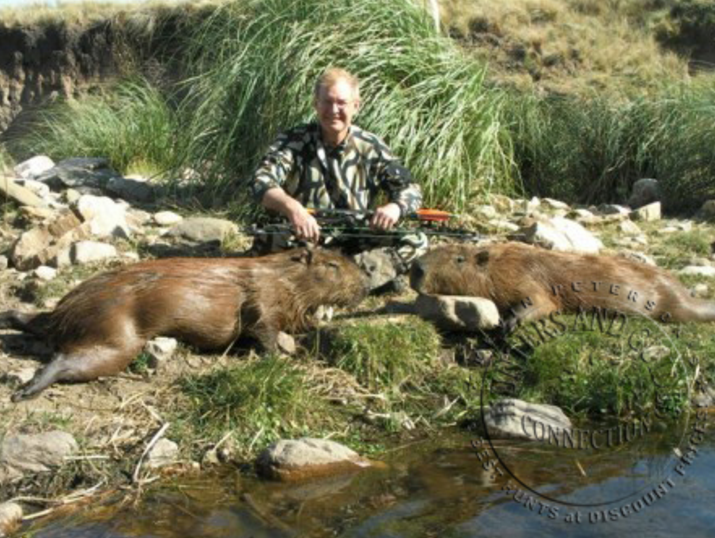
Image: Capybara hunting is legal within Argentina. American hunter with threatened species
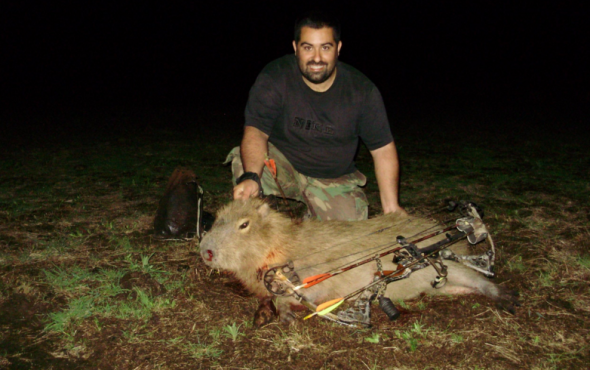
Image: Hunter with threatened Capybara
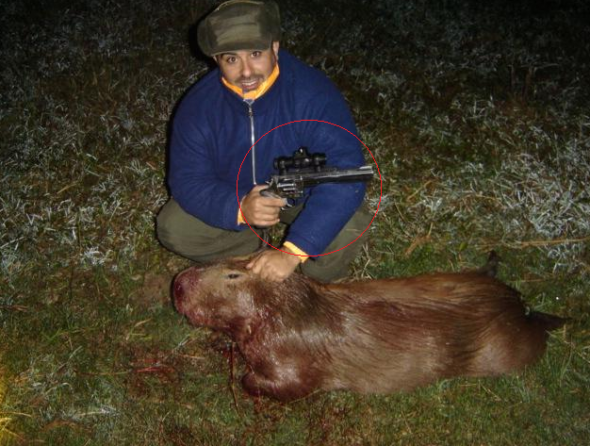
Image: Hunter with threatened Capybara
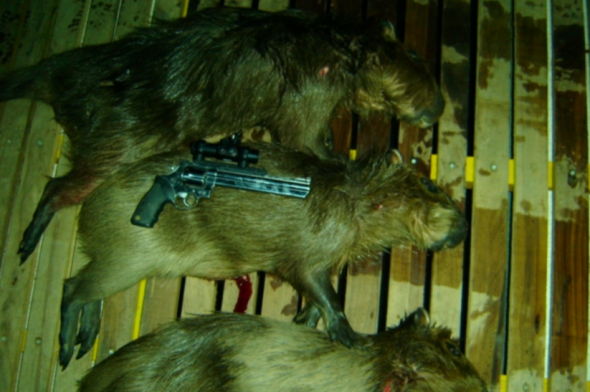
Image: The sickening images of dead Capybara slaughtered with a handgun
The International Union for the Conservation of Nature has stated that the greater Capybara is listed as (least concern) and the lesser Capybara is (data deficient). So whats the big deal then? The IUCN has listed the lesser Capybara as data deficient as they currently do not know how many are remaining within the wild. So while hunting, poaching and the clothing industry takes its share. Research could prove within a few years that the lesser Capybara is in fact seriously threatened.
Meanwhile the greater Capybara that is listed as explained above as (least concern) is seriously threatened by the pressures of hunting. The IUCN quotes:
“This species is severely threatened by hunting; some local populations have been extirpated (Eisenberg and Redford 1999). Capybara leather is valued in South America and from 1976 to 1979 almost 80,000 skins were exported from Argentina (Eisenberg and Redford 1999). There is a large internal market for the skins”
Extinction of the Capybara would have a detrimental affect to the ecosystem:
So as one can see, unless action is taken sooner rather than later to remove one or most of these threats its very likely that we’re going to lose the worlds largest semi-aquatic rodent due to one of the above destructive actions. International Animal Rescue Foundation Brazil that undertakes animal and environmental investigations throughout South America; Stated “should we lose both the lesser and greater Capybara within the ‘wild’. The knock on effect this would have to our already threatened and fragmented ecosystem would be large”.
Capybaras’ are herbivores that consume mainly grasses, aquatic plants, fruits and bark. Should both the larger and greater Capybara go extinct, plant-life would be affected. Herbivores consume plants that contain seeds, these seeds pass through the digestive system of the animals as they are moving around the forest floor, which are then deposited via feces, thus equaling spread of plant-life. One less herbivore means less movement and spreading of plants that are required for other animals to consume, and medicinal plants that humans require for natural medicines.
The same applies to fruit too, not forgetting aquatic plants that need to spread throughout local rivers and streams that fish and small wildlife rely on to conceal themselves within from predators. Alien plants that the Capybara feeds on would also take over the forest floor thus pushing native non-alien plants into extinction. Extinction of both genera of the Capybara would therefore be catastrophic.
International Animal Rescue Foundation Brazil are currently working to increase awareness of the Capybara and will be undertaking demonstrations outside of trading stores that trade in Capybara leather products. You can help International Animal Rescue Foundation Brazil with its current investigations by sending any small or large donation. Simply click here https://www.paypal.com/uk/webapps/mpp/send-money-online add our email that is here: [email protected] then your kind donation, then simply hit send.
The Capyabara pictured below is not protected as many have been led to believe. Furthermore if the clothing and fashion industry as well as the hunting industry is not regulated accordingly we’ll lose the entire species within ten years. The (IARFB) are working on fact sheets for local schools, universities and will be running classes to increase awareness and education about the species of which your help is required. For more information please email the team above.
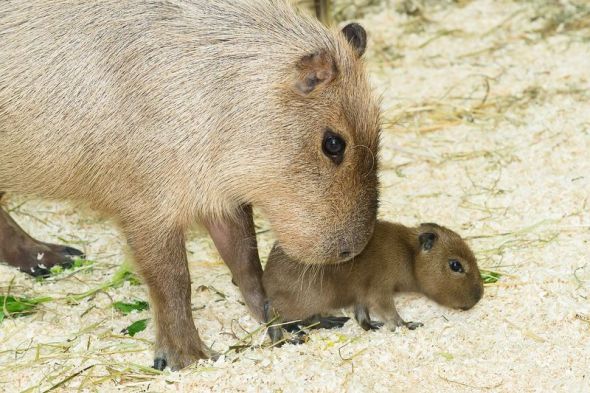 Image: Capybara mother and young
Image: Capybara mother and young
Dr Jose C. Depre.
Environmental and Botanical Scientist.
Director/ CEO
November 7, 2015 | Categories: You must be the change you want to see in the world | Tags: Animals, Argentina, bush meat, Capybara, Dr Jose Depre, Extinction, greater capybara, International Animal Rescue Foundation Brazil, largest rodent on earth, leather, leather gloves, leather shoes, leather wallets, lesser capybara, Peru, rodent, south america capybara, Wildlife | Leave a comment











